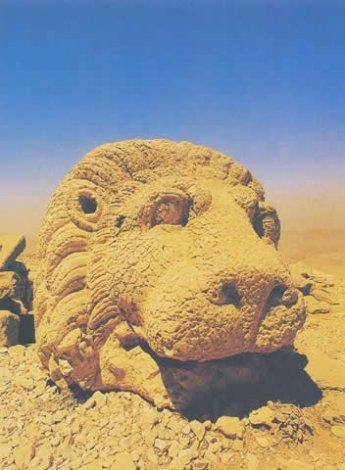Mount Nemrut (2552m) is located in southeastern Turkey, 87 km from Adıyaman, and is part of the Taurus Mountain range, above the Euphrates River valley. It is the site of extensive ruins of the tomb of Antiochos I (69-36 BC) of the Commagene Kingdom (163 BC – 72 AD).


It is believed that the Seleucid Empire (312 BC- 63 BC) gained control of Commagene during the reign of the late 3rd-early 2nd century BC Seleucid king, Antiochus III the Great. This control lasted until c. 163 BC, when the local satrap, Ptolemaeus of Commagene, established himself as independent ruler following the death of the Seleucid king, Antiochus IV Epiphanes. The Kingdom of Commagene maintained its independence until 17 AD, when it was made a Roman province by the Emperor Tiberius. Mithridates I. brought together Persians and Macedonians and other communities in the area to form the powerful state. After Mithridates I, Antiochos I (69-36 B.C.) became the king of Conmmagene and developed his kingdom as a strategic crossroad on the important trade routes between Syria, Mesopotamia and Rome. The kingdom was at the height of its splendor during his time.
The sanctuary at the top of Mount Nemrut was built by Antiochos I for himself as a funerary monument. It is a conical shaped tumulus with a height of 50m and 150m diameter and made up of 50,000 cubic meters of gravel. There were three terraces in the sanctuary on the East, North and West sides. The remains of the sculptures, which once decorated all three, give some idea of the size and grandeur of Antiochus' magnificent structure. Colossal heads of Apollo, Zeus, Hercules, and Antiochos I and several Greek and Persian gods surround the structure. The complex also includes a cave cistern, some reliefs and ruins of columns. The Commagene have been described as a semi-Iranian people that practiced the Zoroastrian faith and worshiped gods with combined Eastern and Western names like Zeus-Orimasdes and Apollo-Mithras.
The site was rediscovered in 1881 by Karl Sester, a German Archaeologist. In 1883, the site was visited by Osman Hamdi Bey, who was the founder and director of Istanbul Archaeological Museum. In 1984, German archaeologists, under the direction of Friedrich Karl Dörner of the University of Münster, began to survey and restore the monuments. The burial chamber of Antiochus has not yet been found.




Hi! I am a robot. I just upvoted you! I found similar content that readers might be interested in:
http://www.turkishculture.org/archaeology/mount-nemrut-1026.htm